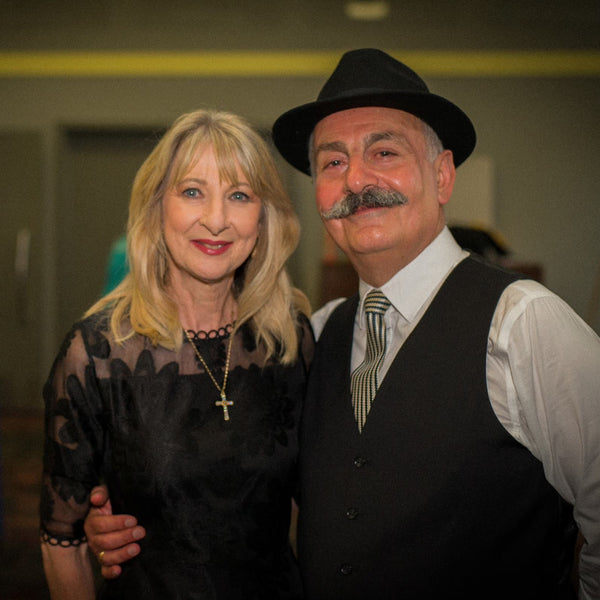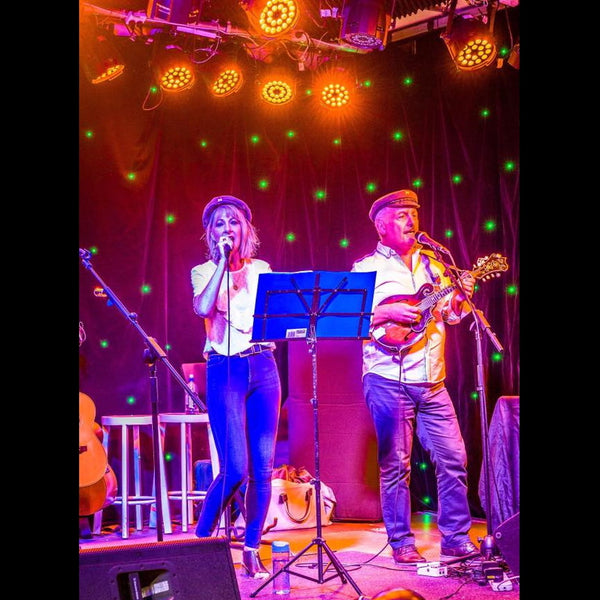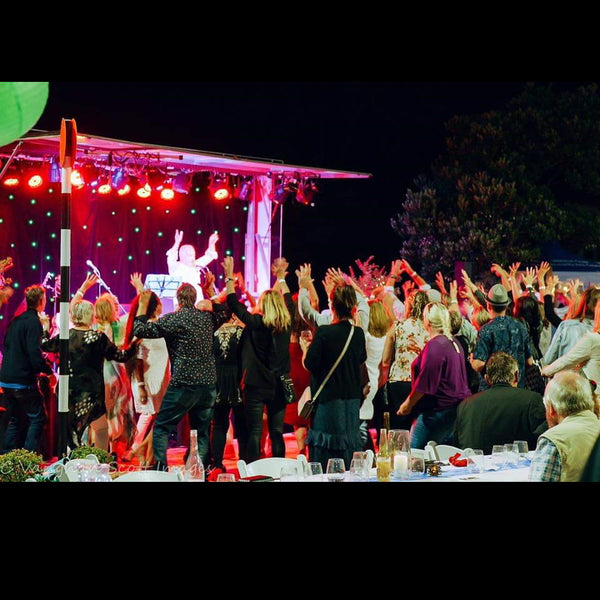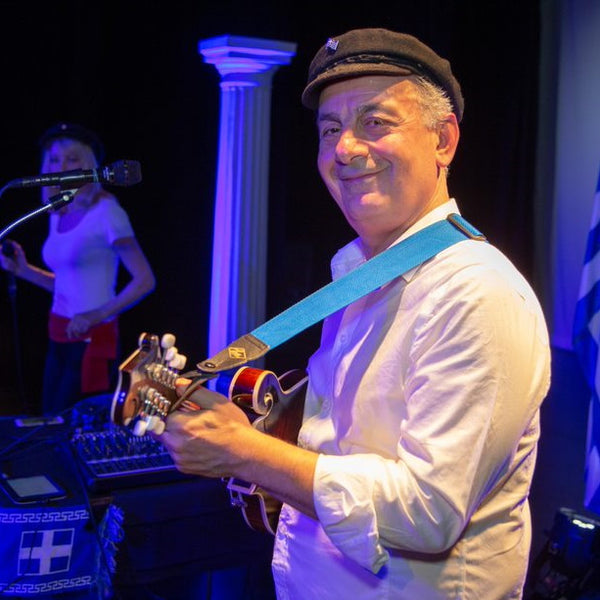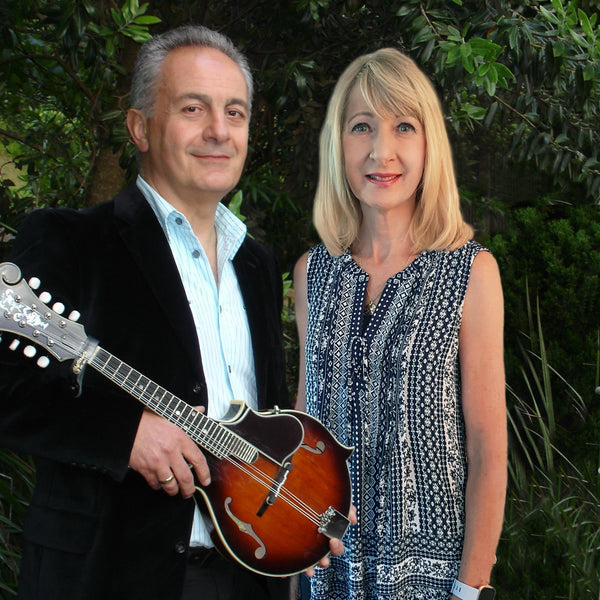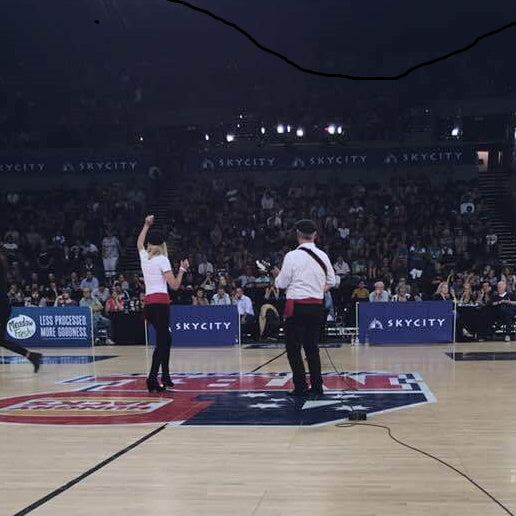The Sounds of Greece music and dance show was established in 2010 by husband-and-wife duo Theo and Cristina Simeonidis. Sounds of Greece provides a nostalgic journey through the varied musical styles of Greece and enables guests to re-kindle memories of their time in that country and to transport them to the Greek islands for a few hours, or to Plaka - the beating heart of old Athens itself.
Theo and Cristina have created the Sounds of Greece programme to bring together music and dance that will transport you to the Greek Islands for a few hours: to create the authentic Greek musical journey, Sounds of Greece uses backing tracks, into which Theo melts some magic leads and harmonies (and occasional vocals) while Cristina's sultry vocals, warmth and smile will ensure your function is enjoyed by all and remembered fondly for a long time. You can also enjoy dancing to the Greek rhythms with guidance from Cristina, who is an experienced dancer and can help guests to engage fully with the theme of your event. By virtue of being a two-piece, and through using backing tracks, Sounds of Greece offers competitive pricing for a night’s entertainment.
Sounds of Greece has performed extensively at a variety of venues and events, including providing half-time entertainment at Spark Arena for a NZ Breakers basketball game; launch functions for Meadowfresh’s Kalo Greek Yoghurt; Destination Orewa’s Beach n Bites, The Longest Table dinner in the main street of Orewa in both 2019 and 2020, weddings, anniversaries reunions, theme parties, restaurant Greek nights and private celebrations.
Are you nostalgic for the sounds of Greece and wish to re-kindle your memories? Are you contemplating ideas for a Greek theme evening, special function or even a fun team-building experience with a difference? If it's a great evening of fun, music, dancing and atmosphere you are after, engage Sounds of Greece for a night at the "Opa!".
Ideal for: greek-themed evening, private party, wedding, corporate event, festival, concert, team building, restaurant
Their music includes songs by many of the great Greek composers such as Mike Theodorakis (“Zorba the Greek”), Manos Hadjidakis (“Never on Sunday”), Giorgos Zambetas, Markos Vamvakaris, Vasilis Tsitasanis, Manos Loizos, Christos Nikolopoulos, Stavros Xaharhos, Michalis Sougioul, Giorgos Mitsakis, Aposotos Kaldaras and many others, as well as songs performed by artists such as Giannis Parios, Marinella, Anna Vissi, Glykeria, Viky Moscholiou, along with traditional compositions and bouncy instrumentals.
Sample repertoire:
Zorba the Greek
The lotus eaters
Never on Sunday
Who pays the ferryman?
Milise mou (Children of the Stars)
White rose of Athens
Star of Mykonos
Hassapiko politico
I gorgona
To gelekaki
Frangosyriani
Ti gliko na sagapoun
Maria me ta kitrina
I filoi
Opa! Opa!
Erotevmenaki
Gialo gialo!
To minore tis avgis
Psaropoula
Ta dakria mou enai kafta
Hronia helidonia
Ximeroni
Harva nagila
Ta paidia tis amynas
An deis ston eipno sou erimia
Pame volta sto fengari
Mikri horiatopoula
Strive spango
Tzamaika
Samiotissa
Zileia mou
Tik tik tiky tiky tak
Oles to kosmou oi kiriakes
I have a dream
Siko horepse syrtaki
Some Greek Dances
Part of the Sounds of Greece experience is sharing with and teaching guests the basics of several Greek dances. The origins of many traditional dances are as ancient as Greek civilisation itself. The ancient Greeks’ love for the dance was such that they believed it had divine origins. Something so beautiful was surely sent by the gods, they reasoned.
There are very many Greek dances still performed today, some having become “national” dances while many others are popular regionally or locally. Greek dances may be divided into two categories: traditional folk and popular folk dances.
Traditional Folk Dances
Traditional folk dances come in many varieties, but can be subdivided into two basic types:
(a) the trailing dances, and (b) the leaping dances. They are proud, stalwart dances, performed in a semi-circle. When danced in ethnic costumes they are very colourful and inspiring. The best known of these dances are the kalamatianos and the tsamikos.
Kalamatianos
The kalamatianos, said to be of ancient origin, is undoubtedly one of the most popular dances in Greece and is danced throughout the country by both men and women. As its name indicates, the dance originated from the province of Kalamata in Southern Greece, where the world-famous kalamata olives come from.
The kalamatianos is danced in a trailing semi-circle to the unfamiliar rhythm of 7/8. It consists of twelve basic steps upon which all the variations are based. The variations are usually performed only by the first, or lead, dancer, who is at the head of the line on the extreme right, facing into the semi-circle.
Tsamikos
The tsamikos is an imposing dance whose rhythm is one of grandeur. Its variations consist of both smooth and leaping steps, which give the dance a triumphant air. In earlier times, the tsamikos was danced in the mountainous areas of Epirus, in Northern Greece, only by men. Today, it is enjoyed throughout Greece by both men and women.
The tsamikos also became the favourite dance of the mountain fighters and rebels (Klephts) of the Greek Revolution of 1821 against the Ottoman Turks. It is danced in a semi-circle, with the leader performing variations while the others follow the basic steps. The deliberate, grandiose nature of this dance stirs considerable excitement in the individual, especially the leader. The peak of the dance exhorts the leader to perform outstanding gymnastic and acrobatic feats.
Popular Folk Dances
Popular folk dances include the hassapikos, hassaposervikos, and the zembekikos. While they are called popular folk dances they actually have little to do with the folk dances of the past. Before World War II, they were performed in rowdy taverns by a tough breed of men called manges. They were grim, unsmiling individuals who were often outside the law. With the passage of time these dances have become fashionable, and are now danced everywhere by all classes of Greeks and visitors - both in Greece and overseas. The syrtaki is another dance that has also become popular over the last 30 years.
Hassapikos
The hassapikos is performed by two or more dancers who execute identical steps. It is danced in a straight line, with each dancer holding the shoulders of their partners. It has many variations and is a stunning dance when performed well. We know very little of the origin of the hassapikos except that it was an ancient dance performed by the Greek butchers of old Byzantium. (The Greek word for butcher is hassapis, hence the name). Before World War II the dance was performed only by men, mostly on the islands and ports. But today, with bouzouki music so popular, the hassapikos is also danced by women and has become an international dance.
Hassaposervikos
The hassaposervikos is a continuation of the hassapikos in a more intensive and vivid rhythm. Though its history and origin are little known today, it is believed to be a blend of the hassapikos and a Serbian folk dance. The dancers stand in a straight line, holding shoulders as in the hassapikos. When space is limited and there are many dancers, they often form a circle and dance facing inwards. The hassaposervikos is a relatively easy dance to learn. It is also fast, frenetic and fantastic fun!
Zembekikos
The zembekikos is believed to be an ancient dance of the Thracean Greeks who emigrated to Asia Minor from Thrace. The zembekikos was originally danced only by men, but today it is also danced by women. It is a very free dance, usually performed by a single dancer or by a couple facing each other. Dancers improvise according to their imagination and feelings, following the distinctive, irregular, driving rhythm of the music as best they can. In performing the zembekikos the dancer dances only for himself, as though no one exists around him. It is recognised as a "heavy" dance, full of emotion and self-expression.
The zembekikos is often known in tavernas as "the ouzo dance" - this derives from the feat performed by the dancer who picks up off the floor, with his mouth, a shot glass of ouzo and knocks it back without any hands being placed on the ground or the glass!
Syrtakis (“Zorba’s Dance”)
The syrtakis is a dance form made popular by the sensationally-successful Mikis Theodorakis soundtrack to the classic film Zorba the Greek. It starts with the steady rhythm of the hassapikos and speeds up into a fast and intense hassaposervikos. You simply cannot leave any Greek function without having joined in Zorba's dance - just as the hero of the film danced on a far, far away beach on the sunny island of Crete!
Hi Robyn,
Theo and Christina were great, they really added to the atmosphere. Was a great night.
Thanks for your help in organising it.
Tom
Hi Robyn,
Sounds of Greece were fantastic! Really easy to work with and we all loved the music!
The event went very well and we had great feedback about the music from our clients as well
Thanks,
Kate
Thank you very much indeed for organising The Sounds of Greece. They were superb and added greatly to our evening. However some of us are still recovering from attempting the Greek dancing !! Thank you again.
Best regards
Lesley Hawes

